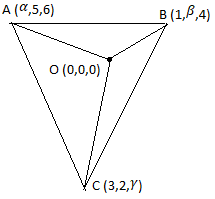
If the centroid of the tetrahedron OABC, cohere A, B, C are given by \[\left( \alpha ,5,6 \right),\left( 1,\beta ,4 \right),\left( 3,2,\delta \right)\] respectively be (1,-1,2) then the value of \[{{\alpha }^{2}}+{{\beta }^{2}}+{{\delta }^{2}}\] equals,
A. \[{{\alpha }^{2}}+{{\beta }^{2}}\]
B. \[{{\delta }^{2}}+{{\beta }^{2}}\]
C. \[{{\alpha }^{2}}+{{\delta }^{2}}\]
D. none of these
Answer
602.7k+ views
Hint:Tetrahedron is a triangular period. Substitute the given vertices in the formula to find the centroid of the tetrahedron. Substitute (1,-1,2) and get the value of \[\alpha ,\beta ,\delta \].
Complete step-by-step answer:
We have been given a tetrahedron OABC. A tetrahedron is also known as a triangular pyramid. It is a polyhedron composed of four triangles faces, six straight edges and four vertex corners.

Let the 4 vertices of the tetrahedron be,
\[O(0,0,0),A\left( \alpha ,5,6 \right),B\left( 1,\beta ,4 \right),C\left( 3,2,\delta \right)\].
Thus the centroid of the tetrahedron can be found using the formula,
Centroid \[=\left(
\dfrac{{{x}_{1}}+{{x}_{2}}+{{x}_{3}}+{{x}_{4}}}{4},\dfrac{{{y}_{1}}+{{y}_{2}}+{{y}_{3}}+{{y}_{4}}}{
4},\dfrac{{{z}_{1}}+{{z}_{2}}+{{z}_{3}}+{{z}_{4}}}{4} \right)\]
Here, \[\begin{align}
& \left( {{x}_{1}},{{y}_{1}},{{z}_{1}} \right)=(0,0,0) \\
& \left( {{x}_{2}},{{y}_{2}},{{z}_{2}} \right)=\left( \alpha ,5,6 \right) \\
& \left( {{x}_{3}},{{y}_{3}},{{z}_{3}} \right)=\left( 1,\beta ,4 \right) \\
& \left( {{x}_{4}},{{y}_{4}},{{z}_{4}} \right)=\left( 3,2,\delta \right) \\
\end{align}\]
Thus, substitute these values in the formula of centroid.
Centroid \[=\left( \dfrac{0+\alpha +1+3}{4},\dfrac{{{0}_{1}}+5+\beta
+2}{4},\dfrac{0+6+4+\delta }{4} \right)\]\[=\left( \dfrac{4+\alpha }{4},\dfrac{7+\beta
}{4},\dfrac{10+\delta }{4} \right)\]
We have been given the values of the centroid as (1,-1,2).
\[\left( \dfrac{4+\alpha }{4},\dfrac{7+\beta }{4},\dfrac{10+\delta }{4} \right)=\left( 1,-1,2
\right)\]
Thus we can say that,
\[\dfrac{4+\alpha }{4}=1,\dfrac{7+\beta }{4}=-1,\dfrac{10+\delta }{4}=2\]
Cross multiply and get the values of \[\alpha ,\beta ,\delta \].
\[\begin{align}
& 4+\alpha =4 \\
& \therefore \alpha =4-4=0 \\
& 7+\beta =-4 \\
& \beta =-4-7 \\
& \therefore \beta =-11 \\
& 10+\delta =8 \\
& \delta =8-10=-2 \\
\end{align}\]
Thus we got\[\alpha =0,\beta =-11,\delta =-2\].
Now we need to find the value of \[{{\alpha }^{2}}+{{\beta }^{2}}+{{\delta }^{2}}\]. If we put
\[\alpha =0\], we get,
\[\begin{align}
& {{\alpha }^{2}}+{{\beta }^{2}}+{{\delta }^{2}}=0+{{\beta }^{2}}+{{\delta }^{2}} \\
& \therefore {{\alpha }^{2}}+{{\beta }^{2}}+{{\delta }^{2}}={{\beta }^{2}}+{{\delta }^{2}} \\
\end{align}\]
Thus, option B is the correct answer.
Note:
Tetrahedron is the simplest of the entire ordinary convex polygon and the only one that has fewer than 5 faces. The tetrahedron is the 3D case of Euclideon simplex. So it can also be called 3-simplex.
Complete step-by-step answer:
We have been given a tetrahedron OABC. A tetrahedron is also known as a triangular pyramid. It is a polyhedron composed of four triangles faces, six straight edges and four vertex corners.

Let the 4 vertices of the tetrahedron be,
\[O(0,0,0),A\left( \alpha ,5,6 \right),B\left( 1,\beta ,4 \right),C\left( 3,2,\delta \right)\].
Thus the centroid of the tetrahedron can be found using the formula,
Centroid \[=\left(
\dfrac{{{x}_{1}}+{{x}_{2}}+{{x}_{3}}+{{x}_{4}}}{4},\dfrac{{{y}_{1}}+{{y}_{2}}+{{y}_{3}}+{{y}_{4}}}{
4},\dfrac{{{z}_{1}}+{{z}_{2}}+{{z}_{3}}+{{z}_{4}}}{4} \right)\]
Here, \[\begin{align}
& \left( {{x}_{1}},{{y}_{1}},{{z}_{1}} \right)=(0,0,0) \\
& \left( {{x}_{2}},{{y}_{2}},{{z}_{2}} \right)=\left( \alpha ,5,6 \right) \\
& \left( {{x}_{3}},{{y}_{3}},{{z}_{3}} \right)=\left( 1,\beta ,4 \right) \\
& \left( {{x}_{4}},{{y}_{4}},{{z}_{4}} \right)=\left( 3,2,\delta \right) \\
\end{align}\]
Thus, substitute these values in the formula of centroid.
Centroid \[=\left( \dfrac{0+\alpha +1+3}{4},\dfrac{{{0}_{1}}+5+\beta
+2}{4},\dfrac{0+6+4+\delta }{4} \right)\]\[=\left( \dfrac{4+\alpha }{4},\dfrac{7+\beta
}{4},\dfrac{10+\delta }{4} \right)\]
We have been given the values of the centroid as (1,-1,2).
\[\left( \dfrac{4+\alpha }{4},\dfrac{7+\beta }{4},\dfrac{10+\delta }{4} \right)=\left( 1,-1,2
\right)\]
Thus we can say that,
\[\dfrac{4+\alpha }{4}=1,\dfrac{7+\beta }{4}=-1,\dfrac{10+\delta }{4}=2\]
Cross multiply and get the values of \[\alpha ,\beta ,\delta \].
\[\begin{align}
& 4+\alpha =4 \\
& \therefore \alpha =4-4=0 \\
& 7+\beta =-4 \\
& \beta =-4-7 \\
& \therefore \beta =-11 \\
& 10+\delta =8 \\
& \delta =8-10=-2 \\
\end{align}\]
Thus we got\[\alpha =0,\beta =-11,\delta =-2\].
Now we need to find the value of \[{{\alpha }^{2}}+{{\beta }^{2}}+{{\delta }^{2}}\]. If we put
\[\alpha =0\], we get,
\[\begin{align}
& {{\alpha }^{2}}+{{\beta }^{2}}+{{\delta }^{2}}=0+{{\beta }^{2}}+{{\delta }^{2}} \\
& \therefore {{\alpha }^{2}}+{{\beta }^{2}}+{{\delta }^{2}}={{\beta }^{2}}+{{\delta }^{2}} \\
\end{align}\]
Thus, option B is the correct answer.
Note:
Tetrahedron is the simplest of the entire ordinary convex polygon and the only one that has fewer than 5 faces. The tetrahedron is the 3D case of Euclideon simplex. So it can also be called 3-simplex.
Recently Updated Pages
Master Class 10 General Knowledge: Engaging Questions & Answers for Success

Master Class 10 Computer Science: Engaging Questions & Answers for Success

Master Class 10 English: Engaging Questions & Answers for Success

Master Class 10 Social Science: Engaging Questions & Answers for Success

Master Class 10 Maths: Engaging Questions & Answers for Success

Master Class 10 Science: Engaging Questions & Answers for Success

Trending doubts
The shortest day of the year in India

State and prove the Pythagoras theorem-class-10-maths-CBSE

A Gulab jamun contains sugar syrup up to about 30 of class 10 maths CBSE

What is UltraEdge (Snickometer) used for in cricket?

What are the public facilities provided by the government? Also explain each facility

Distinguish between the reserved forests and protected class 10 biology CBSE




